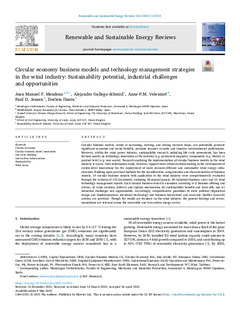| dc.rights.license | Attribution 4.0 International | * |
| dc.contributor.author | Fernandez Mendoza, Joan Manuel | |
| dc.contributor.author | Ibarra, Dorleta | |
| dc.contributor.other | Gallego-Schmid, Alejandro | |
| dc.contributor.other | Velenturf, Anne | |
| dc.contributor.other | Jensen, Paul D. | |
| dc.date.accessioned | 2022-11-11T13:55:05Z | |
| dc.date.available | 2022-11-11T13:55:05Z | |
| dc.date.issued | 2022 | |
| dc.identifier.issn | 1364-0321 | en |
| dc.identifier.other | https://katalogoa.mondragon.edu/janium-bin/janium_login_opac.pl?find&ficha_no=167840 | en |
| dc.identifier.uri | https://hdl.handle.net/20.500.11984/5842 | |
| dc.description.abstract | Circular business models, aimed at narrowing, slowing, and closing resource loops, can potentially generate significant economic and social benefits, promote resource security and improve environmental performance. However, within the wind power industry, sustainability research, including life cycle assessments, has been focused mostly on technology innovation at the material (e.g. permanent magnets), components (e.g. blades) or product level (e.g. new assets). Research analysing the implementation of circular business models in the wind industry is scarce. Such information could, however, support more robust decision-making in the development of system-level innovations for the deployment of more resource-efficient and sustainable wind energy infrastructure. Building upon practical methods for the identification, categorisation and characterisation of business models, 14 circular business models with application to the wind industry were comprehensively evaluated through the revision of 125 documents, including 56 journal papers, 46 industrial business cases and 23 wind technology management reports. Each circular business model is examined according to i) business offering and drivers, ii) value creation, delivery and capture mechanisms, iii) sustainability benefits and trade-offs, and iv) industrial challenges and opportunities. Accordingly, comprehensive guidelines to drive political (legislation design and implementation), industrial (technology and business innovation) and academic (further research) actions, are provided. Though the results are focussed on the wind industry, the general findings and recommendations are relevant across the renewable and low-carbon energy sector. | en |
| dc.description.sponsorship | Diputación Foral de Gipuzkoa | es |
| dc.language.iso | eng | en |
| dc.publisher | Elsevier | en |
| dc.rights | © 2022 The Authors | en |
| dc.rights.uri | http://creativecommons.org/licenses/by/4.0/ | * |
| dc.subject | Circular economy | en |
| dc.subject | Circular business model innovation | en |
| dc.subject | Life cycle thinking | en |
| dc.subject | Low-carbon infrastructure | en |
| dc.subject | sustainability | en |
| dc.subject | Wind farms | en |
| dc.title | Circular economy business models and technology management strategies in the wind industry: Sustainability potential, industrial challenges and opportunities | en |
| dcterms.accessRights | http://purl.org/coar/access_right/c_abf2 | en |
| dcterms.source | Renewable and Sustainable Energy Reviews. | en |
| local.contributor.group | Economía Circular y Sostenibilidad Industrial | es |
| local.description.peerreviewed | true | en |
| local.identifier.doi | https://doi.org/10.1016/j.rser.2022.112523 | en |
| local.relation.projectID | info:eu-repo/grantAgreement/DFG/Programa Red guipuzcoana de Ciencia, Tecnología e Innovación 2020/Project 2020-CIEN-000052-01/GIP/Circularidad y Sostenibilidad de Tecnologías Eólicas/CISTE | en |
| local.contributor.otherinstitution | https://ror.org/01cc3fy72 | en |
| local.contributor.otherinstitution | https://ror.org/027m9bs27 | en |
| local.contributor.otherinstitution | https://ror.org/024mrxd33 | en |
| local.source.details | Vol. 163. Article 112523. July, 2022 | en |
| oaire.format.mimetype | application/pdf | |
| oaire.file | $DSPACE\assetstore | |
| oaire.resourceType | http://purl.org/coar/resource_type/c_6501 | en |
| oaire.version | http://purl.org/coar/version/c_970fb48d4fbd8a85 | en |








